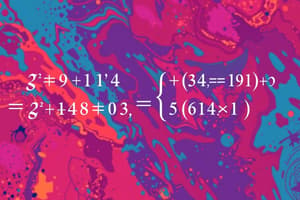Podcast
Questions and Answers
What is the standard form of a linear equation?
What is the standard form of a linear equation?
- $y = ax + b$
- $y = mx + b$
- $ax + b = c$ (correct)
- $ax + by = c$
Which term in the linear function $y = mx + b$ represents the slope?
Which term in the linear function $y = mx + b$ represents the slope?
- $b$
- $x$
- $y$
- $m$ (correct)
What does the y-intercept represent in a linear function?
What does the y-intercept represent in a linear function?
- The minimum value of the function
- The maximum value of the function
- The point where the line intersects the y-axis (correct)
- The point where the line intersects the x-axis
How does graphing linear functions help in understanding algebraic principles?
How does graphing linear functions help in understanding algebraic principles?
What role does slope play in linear functions?
What role does slope play in linear functions?
Why is graphical representation significant in learning algebra?
Why is graphical representation significant in learning algebra?
What does an expression in algebra consist of?
What does an expression in algebra consist of?
In algebra, what does the variable 'x' represent?
In algebra, what does the variable 'x' represent?
What is the term for a variable by itself in algebra?
What is the term for a variable by itself in algebra?
Which mathematical branch deals primarily with symbols, variables, and equations?
Which mathematical branch deals primarily with symbols, variables, and equations?
What operation is used to join two sides of an equation in algebra?
What operation is used to join two sides of an equation in algebra?
What is the essence of solving equations in algebra?
What is the essence of solving equations in algebra?
Flashcards are hidden until you start studying
Study Notes
Exploring Mathematical Wonders with Algebra
Algebra is one of the most versatile branches within mathematics. It deals primarily with symbols, variables, and equations, teaching us how to solve unknowns by manipulating expressions and relationships. Let's embark on this mathematical journey together, exploring some fundamental aspects of algebra along the way.
Variables and Expressions
An integral part of algebra involves representing quantities using letters, called variables. For example, we might represent someone's age using 'x'. A literal is simply a variable by itself; $2x$ represents twice a value represented by x. An expression, conversely, is a combination of numbers, variables, and operators like addition (+), subtraction (-), multiplication (*), division (/), and exponents(^).
Consider the expression (n + 8) where n represents an unspecified number. This demonstrates how variables can help express general situations instead of providing fixed answers.
Equations and Solving
At the heart of algebra lies solving equations, which consist of two sides joined by an equals sign ((=)). In essence, when both sides have equal values, the equation holds true. To find the value of the variables in these equations, we apply operations such as simplification, combining terms, distributing, etc., until reaching the solution.
The linear equation (ax+b=c), where (a), (b), and (c) are constants and (x) is our variable, lays the foundation for understanding more complex concepts later. From linear equations, we advance towards systems of equations consisting of multiple equations and variables.
Linear Functions and Graphing
Linear functions relate changes in input (independent variable) to corresponding alterations in output (dependent variable) through a constant rate of change known as slope (m). These functions take the form (y = mx + b), where m represents the slope, b represents the y-intercept, and x and y denote the independent and dependent variables respectively. By graphing linear functions, students learn visual representations and their properties, paving the way for analyzing nonlinear functions.
Graphical representation plays a significant role in learning algebra because it helps understand mathematical ideas at a deeper level. Plotting points, drawing lines passing through them, finding slopes, intercepts, and recognizing parallel and perpendicular trends are all graphical techniques used to grasp algebraic principles better.
In conclusion, while algebra may appear abstract and daunting initially, its applications span various fields – from everyday life to high-tech industries. As you delve deeper into its realm, you will discover the beauty and power of symbolic reasoning, problem-solving skills, strategic thinking, and creativity that algebra fosters. Embrace your mathematical curiosity, and soon you'll discover the magic woven around algebra!
Studying That Suits You
Use AI to generate personalized quizzes and flashcards to suit your learning preferences.




